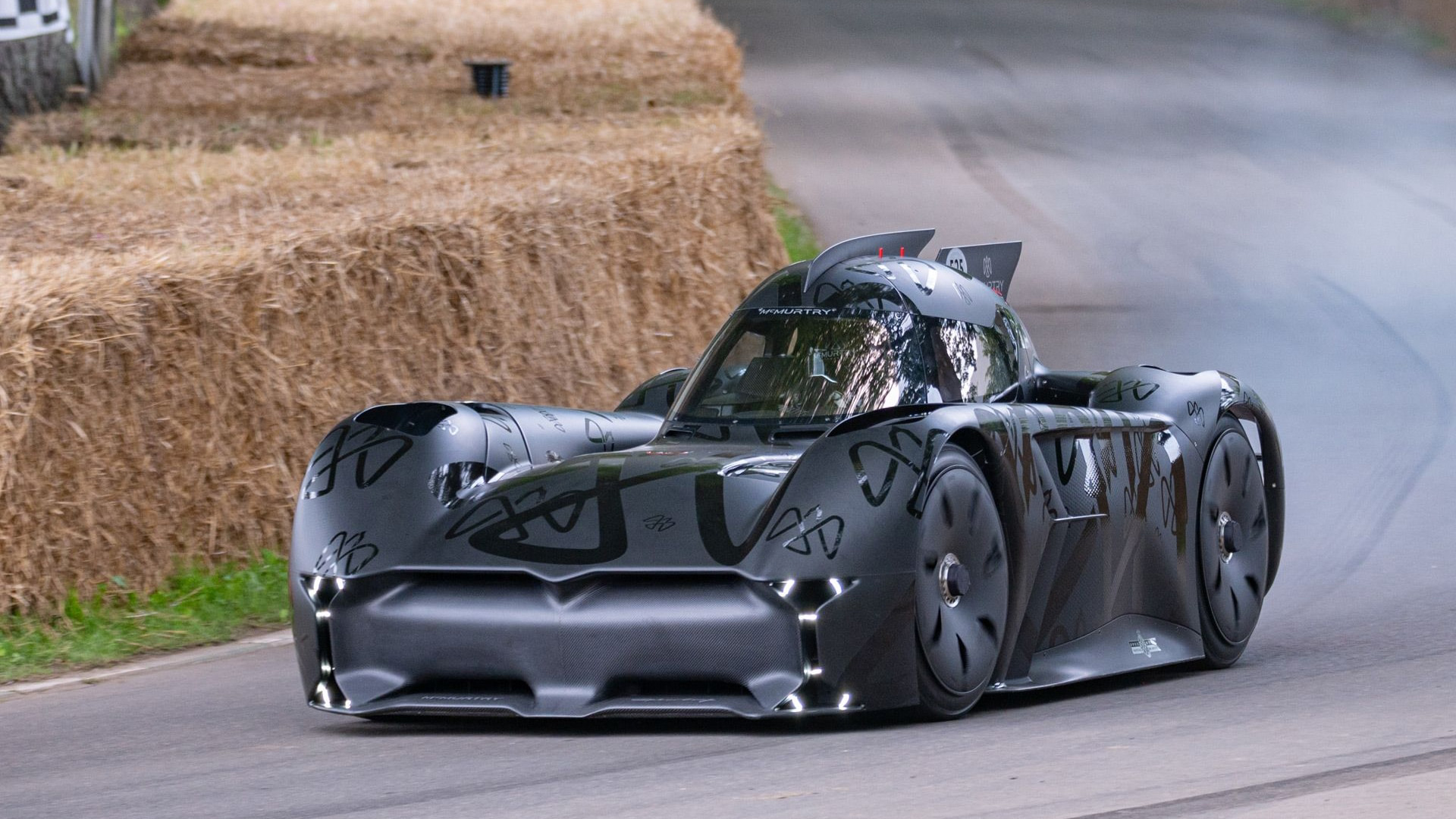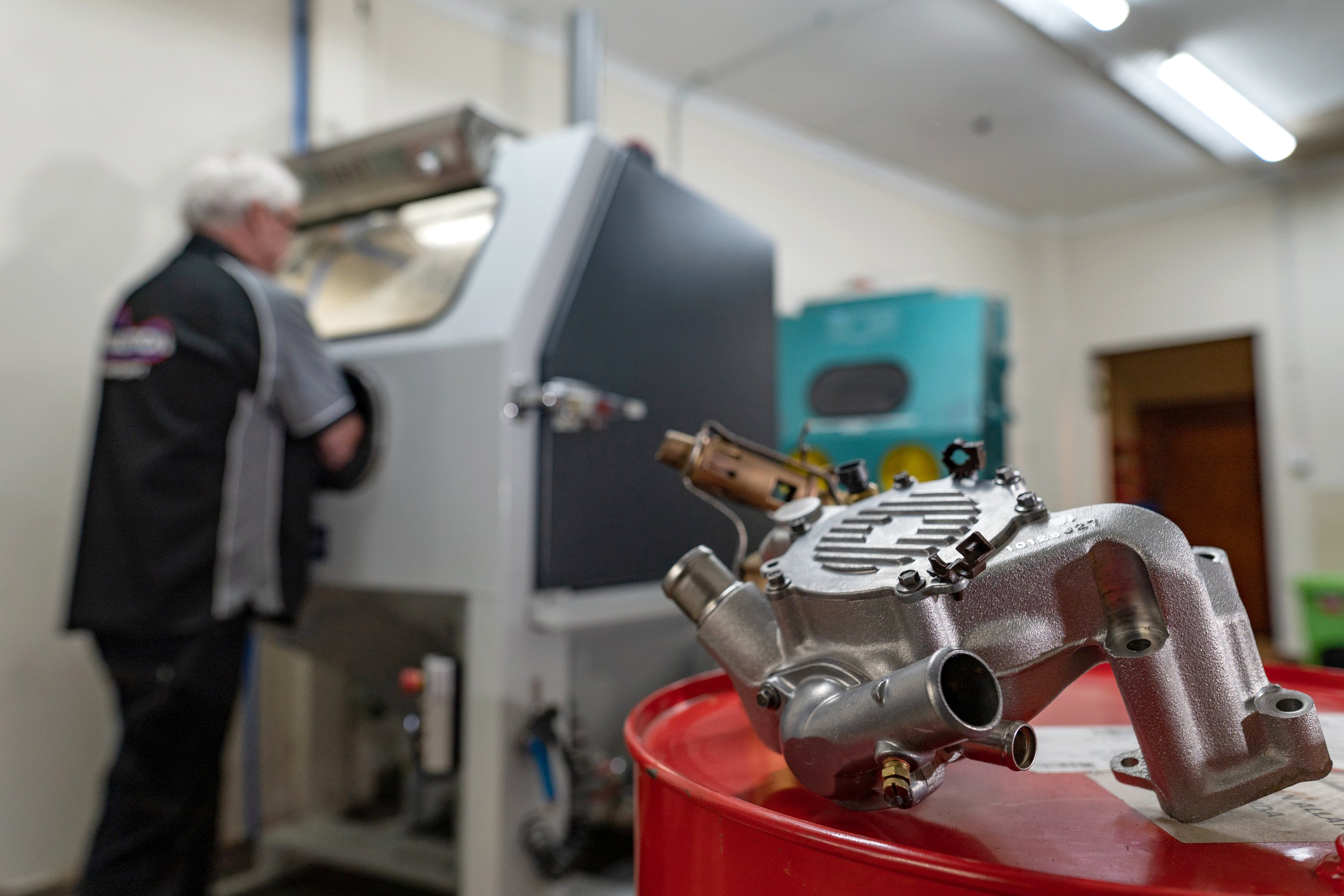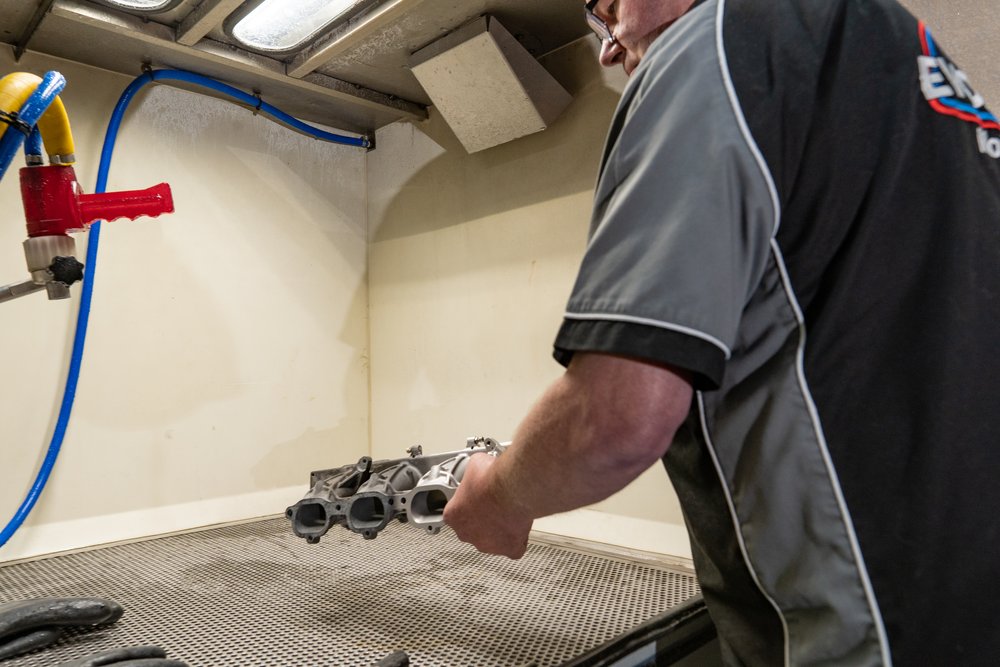Vapour blasting, also known as wet blasting, has been steadily gaining traction in the automotive world. It’s not just a fad but a genuine game-changer for those who take pride in their vehicle restorations. Whether you’re an enthusiast restoring a classic or a professional working in the industry, understanding vapour blasting’s ins and outs can help you decide if it’s right for your next project, either alongside or in place of other dry blasting techniques. At its core, vapour blasting involves mixing abrasive media with water to clean and polish surfaces. Unlike traditional dry blasting, which uses air to propel the abrasive media, vapour blasting incorporates water, creating a slurry that is more gentle yet highly effective. This method is particularly useful for cleaning and finishing surfaces without causing damage or excessive wear.
Vapour blasting is a versatile technique used on a variety of surfaces, particularly metals. It’s ideal for cleaning engine components, aluminium parts, and even delicate surfaces that require a gentle touch. The process starts by preparing the slurry — a mixture of water and fine abrasive media, such as glass beads or aluminium oxide. This slurry is then propelled at the surface under pressure, effectively removing dirt, corrosion, and old paint without damaging the underlying material. In the automotive industry, vapour blasting is commonly used to clean engine parts, carburettors, and gearboxes. It’s particularly effective on aluminium, which is prone to oxidation and corrosion. The result is a clean, polished surface that looks almost new, with the added benefit of a slight peening effect that can improve the fatigue strength of the material.
Vapour Blasting Compared to Dry Blasting
One of the main advantages of vapour blasting is its gentleness. Unlike traditional sandblasting, which can be harsh and damaging, vapour blasting cushions the abrasive media in water. This reduces the risk of surface damage, making it perfect for delicate parts that require a smooth finish. Another benefit is the superior finish vapour blasting provides. The water in the slurry not only reduces friction but also acts as a lubricant, resulting in a polished, satin-like finish that dry blasting simply can’t achieve. This makes it ideal for parts that need to look good, such as engine covers and other visible components. Vapour blasting is also cleaner than dry blasting. The water in the process helps to trap and settle the dust, making it less messy and reducing the need for extensive cleanup. This also makes it a more environmentally friendly option, minimising airborne particles and contaminants. Despite its many advantages, vapour blasting does have some downsides. For one, it requires a more complex setup than traditional dry blasting. The equipment can be more expensive, and the process is slower, which might be a consideration for larger projects or commercial operations. Another potential downside is the need for thorough drying after the process. Since water is involved, all parts must be carefully dried to prevent corrosion, especially for ferrous metals. This additional step can add time and complexity to the process. Compared to other media blasting types, vapour blasting stands out for several reasons. Traditional sandblasting, for example, can be too aggressive for certain materials, causing pitting or excessive wear. Bead blasting, while effective for cleaning, doesn’t provide the same polished finish that vapour blasting does. Soda blasting is another alternative but can be less effective at removing tough grime and old paint. Vapour blasting offers a balanced approach — it’s gentle yet effective, providing a high-quality finish that other methods can’t match. The use of water reduces dust and airborne contaminants, making it a safer and cleaner option for both the operator and the environment.

Restoration Applications
In the automotive restoration and maintenance world, vapour blasting is quickly becoming a goto method for those seeking a gentle yet effective cleaning and finishing solution. Its ability to provide a superior finish, combined with its cleaner and more environmentally friendly process, makes it an attractive option for professionals and enthusiasts alike. While it has some downsides, such as higher equipment costs and the need for thorough drying, the benefits often outweigh the drawbacks. Whether you’re working on a classic car restoration or maintaining high-performance parts, vapour blasting can help you achieve the results you’re looking for. So, next time you’re faced with a challenging cleaning project, consider trying vapour blasting — you might just find it’s the perfect solution for your needs. Next, we hear from some industry specialists about various blasting techniques, equipment, and applications and how they can best be used for whatever challenges your restoration project requires.
Vapour blasting cabinets
Vapour blasting cabinets are designed to contain the vapour blasting process within an enclosed workspace, making them ideal for cleaning small parts. The enclosed design helps to prevent dust and wastewater from contaminating the surrounding area but limits the size of the objects that can be treated. The enclosed workspace prevents dust and wastewater from contaminating the surrounding area, making it a safer and cleaner process and allowing for detailed and precise blasting of small parts, ensuring that every part of the surface is evenly treated without affecting other components nearby. There’s better control over the blasting process, including pressure and media flow, which is crucial for delicate or intricate small parts. Also, a vapour blasting cabinet can make the process more efficient than using larger-scale equipment unsuited for small-scale tasks. Mini tumbler barrels offer the option to evenly blast many small parts (e.g., nuts and bolts). A stainless steel turntable can be fitted for easy manoeuvrability within the blast chamber. For larger/heavier components, a roll-in–roll-out trolley with rails external to the cabinet can be fitted for easier component loading.
Different media types explained
Aluminium oxide is known for its durability and hardness and is ideal for heavy-duty cleaning. Some specific surfaces should not be cleaned with aluminium oxide in vapour blasting. Aluminium oxide is a highly aggressive abrasive, which can be too harsh for delicate or soft materials. Surfaces that are generally unsuitable for cleaning with aluminium oxide include soft metals such as aluminium and brass, which can be damaged by the high hardness of aluminium oxide, resulting in an undesired rough surface or even surface material loss. Using aluminium oxide on glass can lead to scratching and etching.
Crushed glass is made from recycled glass and is a versatile media for various coatings. Garnet is a dense and effective media for removing heavy rust and corrosion. Glass beads provide a softer, smoother finish, while plastic media is gentle enough for delicate surfaces.
Because wet blasting technology cleans by flow rather than impact, water combined with media acting as a lubricant can result in a ‘soft’ finish to components. Different blast techniques can be used to create highlights on components by giving them different textured finishes.

Central Blast: Specialists in Mobile Blasting
Central Blast is NZ’s largest vapour blasting specialist for surface restoration; we talk to owner Joel Oswald about the advantages of vapour blasting and debunk the misconception that vapour blasting is for small engine-type items only, with a focus on how it can be used in mobile set-ups
When people think about vapour blasting, they often think of a blast cabinet that restores engine parts to brand new. However, while it provides exceptional cabinet-based results on all types of smaller and precision components like engine parts, vapour blasting is not restricted by the size of the object being treated in any way. With our fully self-contained mobile trucks and 40-plus metres of hose, Central Blast can vapour blast pretty much anything, anywhere.
Not only does Central Blast strip paint, rust, corrosion, and decades of grime off many different surfaces, but more importantly, we give you back countless hours of painful manual preparation using chemicals and hand tools, as well as a far superior finish.
From trucks, boats, motorbikes, and caravans to cars: underbody, chassis, body, engines, gearboxes, diffs, wheels, and suspension can all be blasted with virtually no risk. While vapour blasting is similar to traditional sandblasting, it uses lower pressures and water as the containment method for airborne dust particles and, therefore, produces no heat in the process. Unlike abrasive dry blasting, which can be harsh on surfaces and introduce heat, vapour blasting gently removes contaminants, paint, rust and surface imperfections without damaging the underlying material.
Aluminium, steel, carbon fibre, fibreglass, concrete and wood can all utilise vapour blasting as a solution for surface restoration. It is fast, chemical-free and non-toxic. Our mobile and cabinet vapour blasters have endless applications; when people ask me, ‘What do you blast?’, it’s a lot quicker to tell them what we don’t …
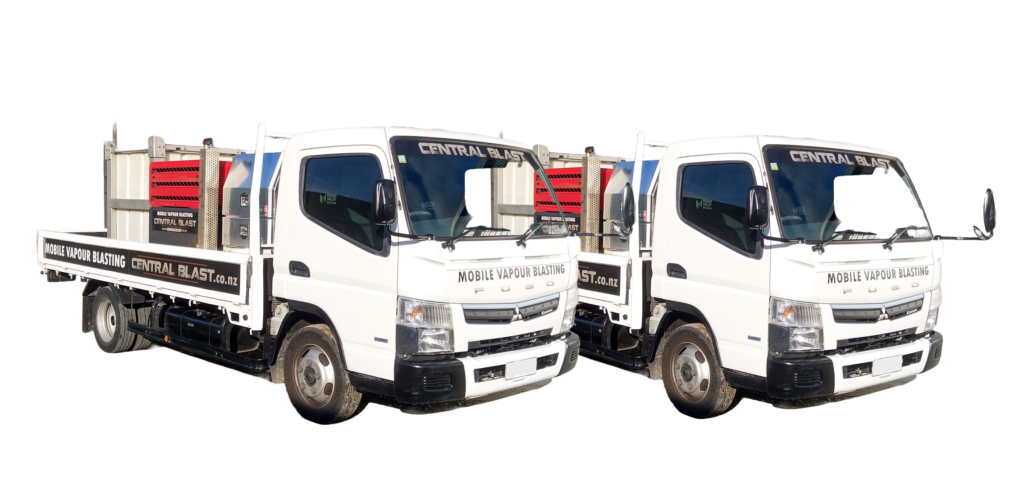
NZ Performance Car: What abrasive media do you use in your blasters?
Central Blast: For our mobile units and generally for steel applications, we use a natural rock mineral called garnet, which people know or refer to as ‘sand’. It is angular and tough and removes layers of paint or years of rust, leaving a clean surface with a good profile for paint adhesion.
In wet-blast cabinets, we use manufactured glass beads, which are a round media that is gentle on the substrate and gives a perfectly clean, smooth finish. Other abrasives, such as soda, walnut shells, crushed/recycled glass, and plastic, can also be used.
What services can your mobile blasting units provide over cabinet blasting?
We provide surface restoration (blasting and protective coatings) for a wide range of applications, from industrial plants and forest machinery to city council graffiti removal. Of course, we do a lot of classic car restorations — rust, paint and bog removal, and underbodies. CoF and WoF surface-rust–related failures have become more common lately, so we provide a quick and easy solution for this.
What are the advantages of vapour blasting over other abrasive blasting methods?
Vapour blasting uses water vapour, with the abrasive media at lower blast pressures providing a 92-per-cent reduction in airborne dust produced compared to traditional sandblasting. As the media hits the surface and breaks up, the dust it would otherwise create is trapped inside the water. This advantage allows us to blast in areas where dry blasting would not be suitable, given the surrounding environment. Additionally, the presence of water in the process means no heat is introduced to the process and to the surface being blasted, therefore removing the risk of panel warping or excessive deterioration. Basically, it cleans off rust and paint by using a constant flow of water and abrasive media, not by high-pressure impact.
What items usually are vapour blasted using a blast cabinet?
Generally, smaller items, such as engine intakes, carburettors, blocks, heads, gearboxes, etc., are placed inside the cabinet. Our cabinet can accommodate up to 100kg in weight and around 1m x 1m in size. Wet-blast cabinets give an excellent finish, making the cleaned items look better than new.
Central Blast services the northern and central regions and everywhere in between with mobile units located across the North Island and has courier and car transporter services available; contact them on 021 489 766 or at centralblast.co.nz for more information.
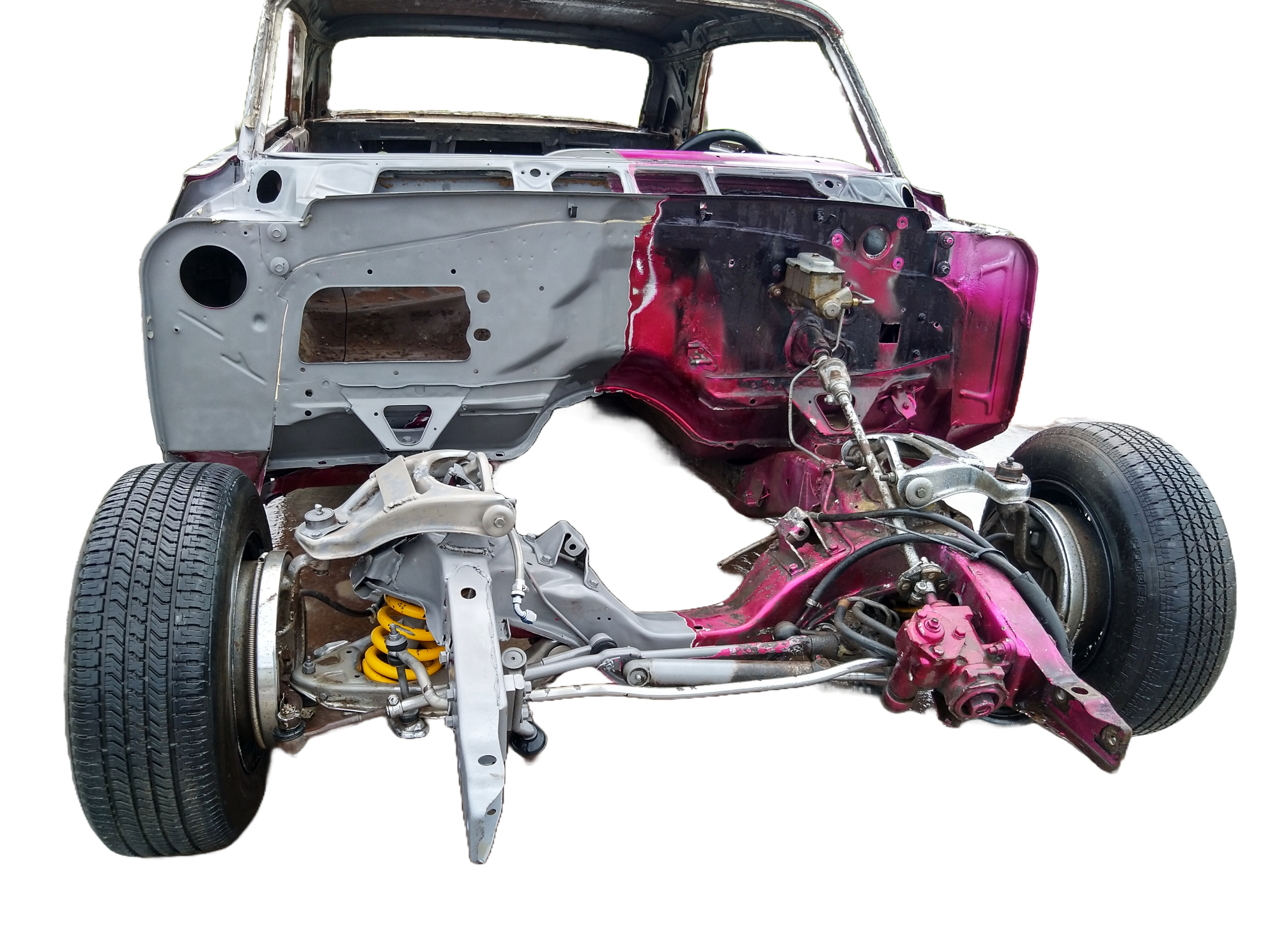
Evolution Motorsport: Experts in Restoration
As a specialised boutique restorer for race and collectible cars, Evolution Motorsport has garnered an extensive client list from around the world thanks to their attention to detail and extensive experience; we spoke to owner Rick Michels to find out where and how vapour blasting can be used in the restoration process
A premier motorsport and restoration business specialising in classic race car and road car restoration, Evolution Motorsport has been a significant player in the national race car industry since the early 1990s. Their reputation has grown through word of mouth, with clients entrusting them with projects of all levels, and their experience in race car preparation and competition makes them a trusted name in the industry. They are a familiar presence at race circuits nationwide, where you may have seen their well-stocked trucks providing race-side support.
Based in Southland, Evolution Motorsport services clients globally, working closely with them from project inception to completion. The proximity of their Invercargill workshop to Teretonga racetrack offers a perfect venue for testing race cars and providing driver training. A comprehensively set-up workshop equipped with a variety of welding equipment, in-house fabrication facilities, benders, folders, MIG and TIG welders, and machining facilities such as milling machines and lathes allows Evolution Motorsport to handle a wide range of restorative and preparatory tasks with precision and efficiency.
For their restoration processes, Evolution Motorsport can clean all metals (including aluminium, bronze, brass, cast iron, copper, stainless steel, steel, and titanium), as well as some rubbers, plastics, wood, and glass. Alongside dry glass blasting, ultrasonic cleaning, hotwash cleaning, and chemical bath cleaning, Evolution Motorsport uses the industry-leading Aquablast 1215 vapour blasting machine. Providing an alternative to dry blasting, this delivers a dust-free, soft-surface finish that keeps components cleaner for longer.
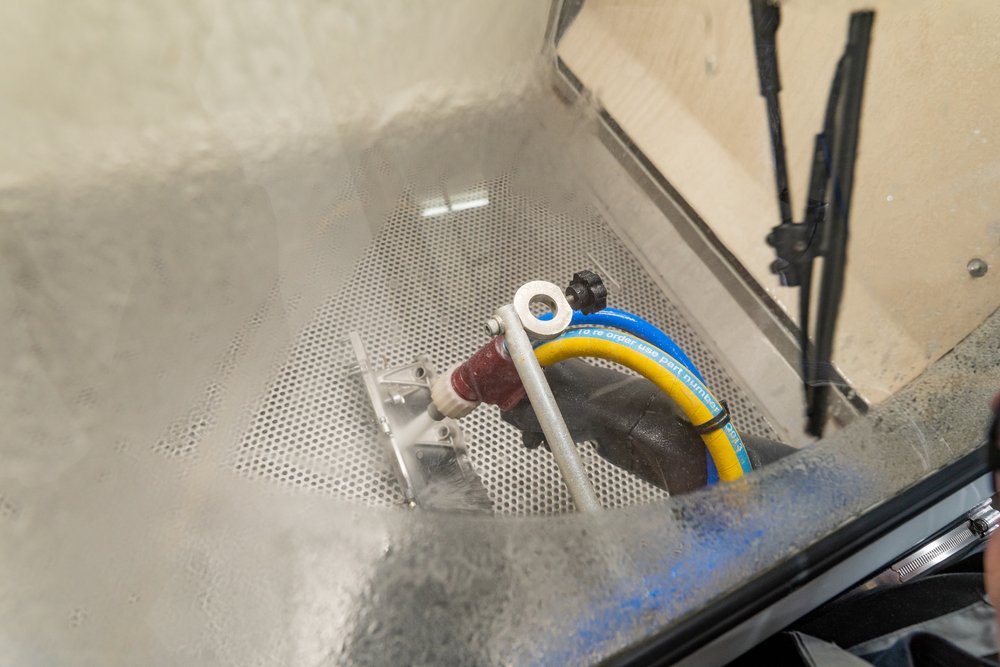
NZ Performance Car: What are the benefits of vapour blasting in the restoration process?
Evolution Motorsport: Vapour blasting provides a high-level satin finish. It cleans by flow, eliminating impact and acting as a lubricant. This avoids media impregnation and extends the life of the blast media. It’s non-corrosive, gentle, and environmentally friendly. Importantly, it maintains critical dimensions and doesn’t warp or heat parts.
What are your specialised vapour blasting services and recommendations as a maintenance and restoration provider?
Evolution Motorsport specialises in vapour-blasting mechanical car parts for a variety of vehicles, including bikes, cars, and vintage machinery. We also regularly blast antique items, ensuring that the original parts are not altered in any way. Vapour blasting is particularly advantageous for delicate components that require gentle handling.
What should be factored in when considering whether vapour blasting is suitable for a project?
We’d recommend vapour blasting for its ability to provide a high-quality, non-corrosive finish that maintains the integrity of the parts. It is a cleaner process that avoids the issues associated with traditional dry blasting methods, making it ideal for preparing parts for the next stage of restoration or maintenance. If you’re after specialised assistance on a restoration or race car project, contact Evolution Motorsport for more information on 0274 342 018 or visit their website at evolutionmotorsport.co.nz.
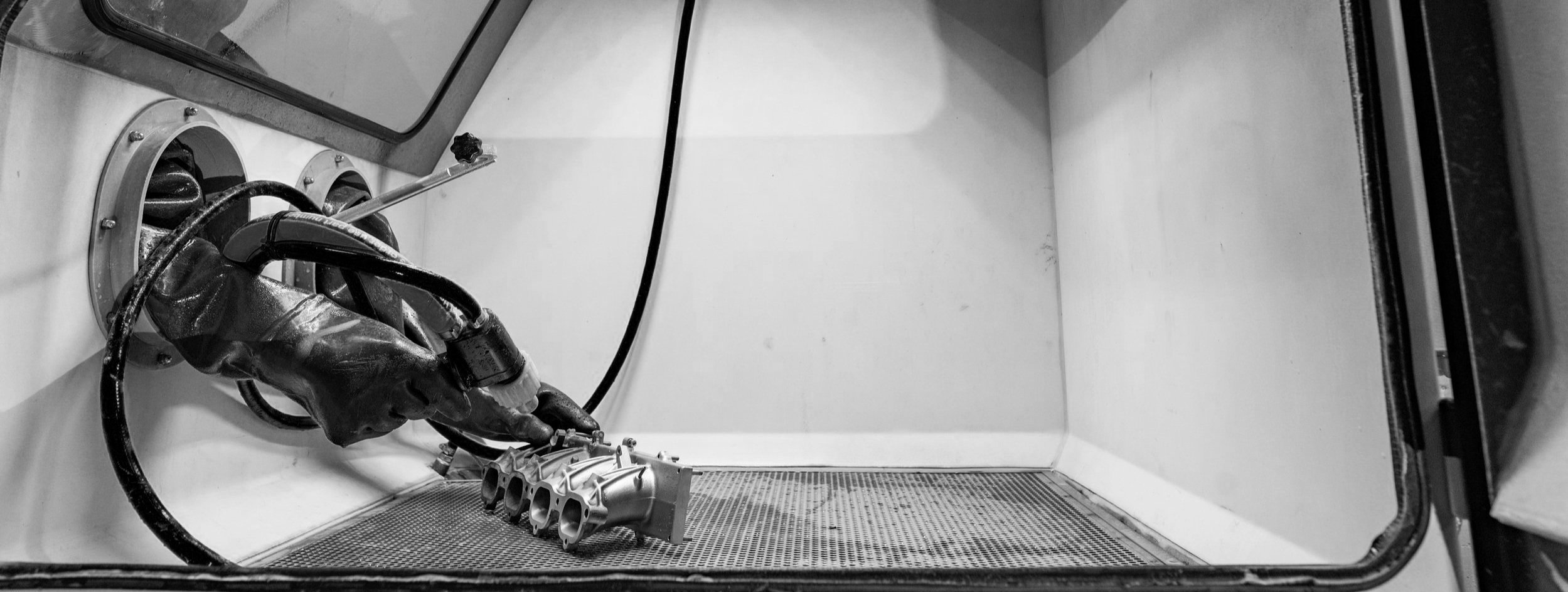
Autoblast: Media Blasting for Vehicle Restoration
Autoblast has been a cornerstone in the vehicle restoration industry for over 20 years, with expertise in media blasting, specialising in underbody restorations, rustproofing, and vehicle shell stripping. We talk to business owner Dave Kirkham about the applications and processes where dry media blasting may be advantageous over wet-blasting techniques as well as getting more detail on when vapour blasting can be appropriate as part of the restoration process
Media blasting is a method of removing contaminants or coatings from a surface, while adjusting the substrate’s profile to meet specific coating requirements. Autoblast primarily uses garnet as its blasting media. The flexibility in the grade or fineness of the media allows for precise adjustments to achieve the desired results. For instance, many epoxy coatings perform optimally with a 50-micron etch, making this technique ideal for vehicle shells, most vehicle parts, and underbody blasting.
Dry media blasting can be particularly beneficial when introducing water to the component is undesirable. This method ensures that the substrate is cleaned and prepared without the risk of water damage, which is crucial for certain vehicle parts.
Vehicle underbody restorations involve meticulous rust removal and application of protective coatings. The use of arc metal spray provides a durable galvanized layer, while Autoblast’s proprietary AutoLAST system offers comprehensive rustproofing. These methods ensure that vehicles remain in excellent condition, even in harsh environments.
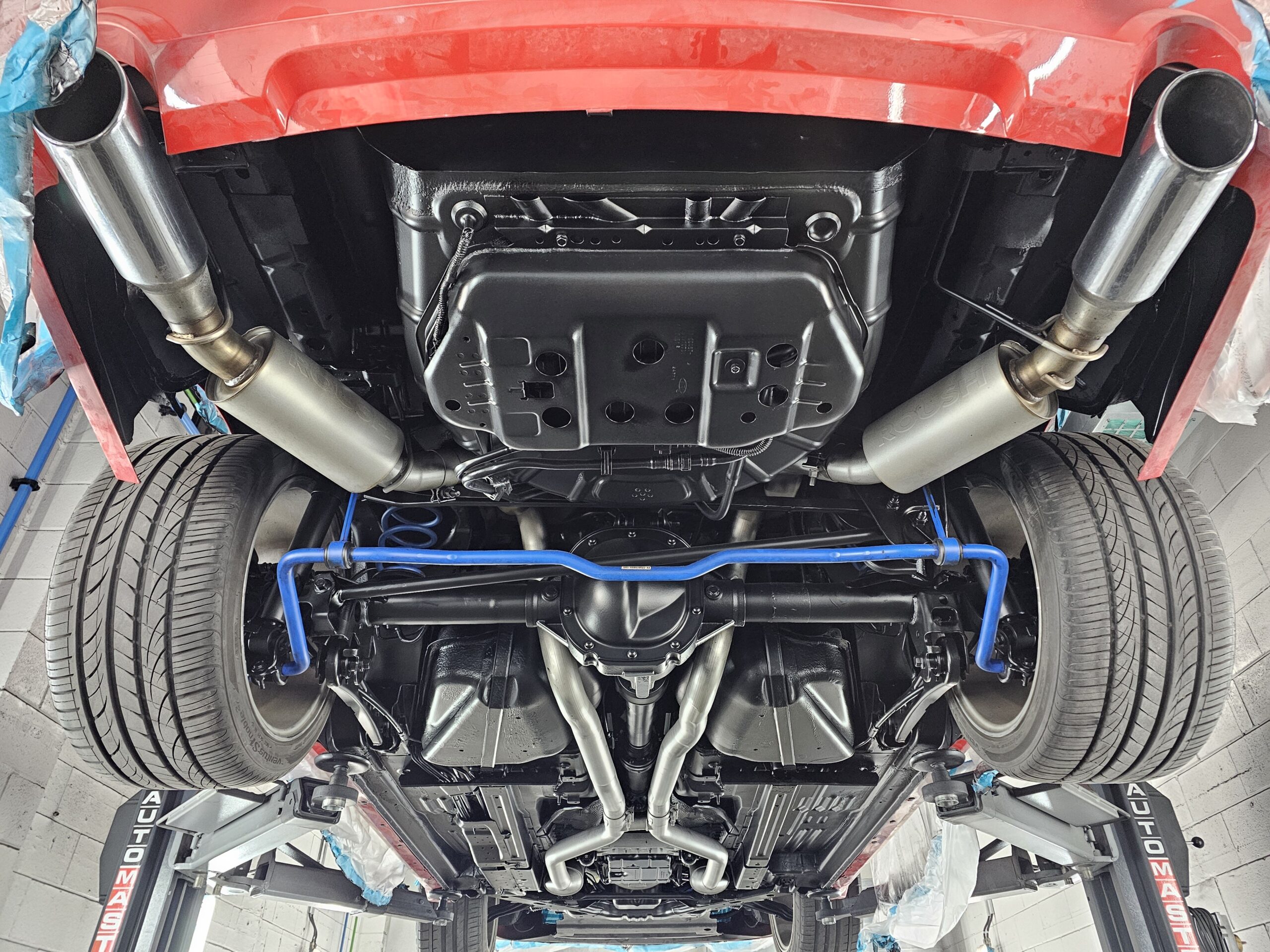
NZ Performance Car: What are the processes Autoblast specialise in?
Autoblast: We focus on vehicle underbody restorations via rust removal and a variety of recoating process options including galvanizing via arc metal spray as well as underbody rustproofing via the AutoLAST hybrid rustproofing system. Secondly, we strip vehicle shells and we also do a few automotive parts.
Is vapour blasting better than other media blasting and cleaning techniques or is it just better suited to certain purposes?
Vapour blasting is exactly the same as other forms of blasting. All it does is introduce water. Introducing water doesn’t matter to certain substrates and brings the benefit of controlling dust. However, introducing water to anything steel isn’t generally sensible.
Vapour blasting offers several advantages over traditional media blasting techniques:
• Dust control: The introduction of water in vapour blasting helps control dust, making it easier to see the workpiece and reducing the risk of dust-related hazards.
• Enhanced cleaning: The water helps clean the substrate of debris, providing a cleaner surface for further processing.
• Versatility: Vapour blasting is suitable for alloy components and outdoor applications where dust control is critical.
Vapour blasting is ideal for alloy components that require a super-fine media, however, it is essential to note that introducing water to steel substrates is generally not advisable, as it can lead to rust and other issues.
What are the media options available in vapour blasting?
Different types of media can be used in vapour blasting to achieve various finishes and textures:
• Aluminium oxide: Used for its fine grade, aluminium oxide offers excellent dust control benefits when used in vapour blasting.
• Crushed glass: This media is advantageous for outdoor blasting as it does not leave residue like garnet. Its affordability also makes it a popular choice.
• Glass beads and plastic media: These media types offer different benefits in terms of texture and finish, with glass beads providing a smooth finish and plastic media being suitable for delicate parts.
What are the benefits of using aluminium oxide or crushed glass as abrasives in vapour blasting?
Aluminium oxide offers fine-grade blasting with dust control benefits, while crushed glass is useful for outdoor blasting, leaving no residue and being cost-effective. Glass is the same hardness as garnet on the Mohs scale, but blasting with garnet will leave big red patches in the grass whereas crushed glass will disappear and not need to be cleaned up.
How does Autoblast’s underbody restoration process use media blasting and what other techniques are employed?
The first step is blasting the underbody rust. Autoblast uses a two-post hoist in a blast booth to elevate the vehicle, ensuring complete access. Wheels, chassis guards, and plastic panels are removed as necessary, then the affected areas are blasted back to ‘clean white’ metal, providing better surface preparation than the factory original.
After blasting, the vehicle is transferred to the paint booth where it’s masked up for one of the following coating options: galvanising, epoxy coating, or cavity waxing.
Arc-metal spray galvanizing is the best coating solution for underbody protection, especially for vehicles exposed to salt or lime on roads, like those used on beaches or imported from the UK or northern Japan. It ensures chassis longevity and is recommended for 4x4s used for towing boats or beach driving and all UK imports.
Epoxy urethane is a high-quality 2K marine-grade urethane designed in New Zealand. It is very hard-wearing and performs better than all factory coatings. While it is a cheaper option than galvanizing, it is still highly effective and is considered the best undercoating solution available in New Zealand, aside from galvanising.
The final step is applying cavity wax. This product is sprayed inside chassis rails and box sections, containing rust killers/converters and remaining elastic to repel water and restrict rust growth. It offers excellent additional rust protection and can inhibit existing rust.
Autoblast’s commitment to excellence is evident in their motto: ‘Be a little bit better every day in every way’. Over the past two decades, they have continuously refined their systems and processes, establishing a solid reputation in underbody vehicle restoration and rustproofing. Their expertise and dedication to improvement have made them a trusted name in the industry. For more information about Autoblast and their services, visit autoblast.nz.
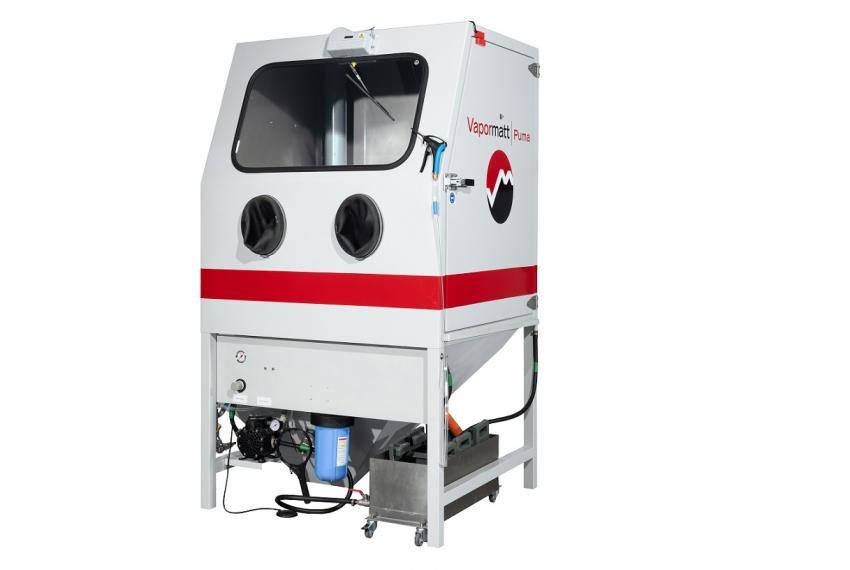
Syntech: Surface-Finishing Suppliers
Since the early ’70s, Syntech has been involved in the surface-finishing market, specialising in the supply of surface-finishing machinery, media and tools, and a selection of high-quality abrasive blasting equipment, cabinets, and blast booths
For wet-blasting solutions, Syntech offers the world’s leading brand of wet blasters, Vapormatt. As experts in and originators of the wet blasting process, Vapormatt has provided customers worldwide with surface processing and wet-blast cabinet solutions for high-value industrial components since their establishment in 1978. Vapormatt has continually developed high-end wet blasting technology with a strong focus on investment in research and development. It holds many patents for process control, blast slurry conditioning, media filtration, and blast gun systems. In short, they are often regarded as the leading equipment brand for industries requiring some of the best solutions for wet blasting.
As an example of how advanced Vapormatt vapour blasting machines’ technology is, we take a look at a particular specialised application, with their use in preparing components and lightweight composite surfaces for bonding in the manufacturing process of a high-end sports car manufacturer.
Case study: Preparing surfaces for bonding on the McMurty Spéirling hypercar
Vapour blasting provides a perfect solution for the extreme standards required to prepare composite surfaces for bonding in the high-tech field of hypercar building. Motorsport enthusiasts may recall seeing the McMurtry Spéirling hyper car smash the hill record at Goodwood in 2022. The combination of a 1,000bhp-per-tonne, an electric fan delivering 500kg of negative lift from zero mph and a lightweight single-seat composite body helped make the racing car unbeatable up the hill. With a zero-to-186mph time of nine seconds and capable of pulling 3G in corners, it stunned spectators and car reviewers alike with its amazing performance. McMurty has identified that electric cars are generally growing in size and weight in their pursuit of speed and range, but they have taken a different approach by delivering compact vehicles with performance and range beyond comparison. Part of their winning formulae is ‘light weight’, and light weight in the motorsport world typically involves composites and other lightweight materials that are bonded together — traditional fasteners add too much unwanted weight.
With such incredible performance, it’s no surprise that the Spéirling’s tiny body is constructed in this way. Given the enormous forces the car is subjected to, it’s crucial that the bond strength is as strong as possible. And to help ensure the strongest possible bonding performance, McMurty has installed a Vapormatt Vapormate manual wet-blasting machine. The compact manual Vapormate is perfect for cleaning components and preparing surfaces for bonding. Wet blasting removes oil and grease and creates a highly clean reactive surface that is ideal for bonding, and because the surface has been perfectly prepared, the bond strength is as strong as it can possibly be. The manual Vapormate is also ideal for McMurtry’s smaller wet blasting volumes, where the components to be blasted frequently vary in size and shape. The Vapormate has plenty of other benefits, too, including a particularly large working area for its small footprint, a wide opening window with hinge rest for easy component loading, height adjustment, and it’s been designed so that it can be delivered on a single pallet and will fit through a standard doorway when constructed. Like all Vapourmatt’s manual wet-blasting machines, the Vapormate is fully featured, so you can achieve the exact finish you need. Features include blast pressure adjustment, rinsing, drying and a moving bed filtration system.
For more information on Vapormatt vapour blasting equipment or other blasting solutions and abrasive consumables, visit syntechnz.com or contact Syntech on 0800 SYNTECH, or email sales@syntechnz.com. As surface-finishing supply specialists, Syntech has offices in Auckland and Christchurch, with a full workshop and demonstration facility, and vans on the road for installation, commissioning, and service maintenance.
